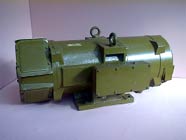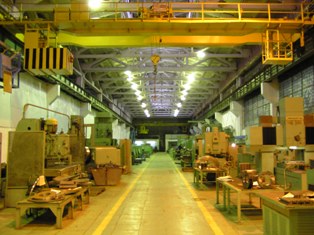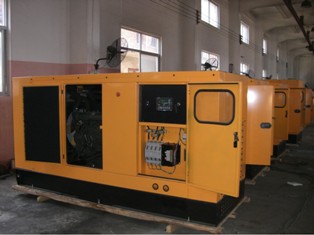Electromechanical amplifiers
An amplifier is a device in which a low power signal (input quantity) controls a relatively high power (output quantity). In this case, the output value is a function of the input signal and the gain occurs due to the energy of an external source.
V amplifiers of electric machines output (controlled) electrical power is generated from the mechanical power of the drive motor.
Electromechanical amplifiers (EMUs) are DC collector machines.
Depending on the method of excitation, electric machine amplifiers are divided into longitudinal field amplifiers and transverse field amplifiers.
Longitudinal field amplifiers, where the main excitation flux is directed along the longitudinal axis of the machine, include:
1) independent electric machine amplifier,
2) Self-excited electric machine amplifier,
3) two-machine amplifiers,
4) two-collector electric machine amplifier,
5) two- and three-stage electric machine amplifiers of the longitudinal field
Transverse field amplifiers, in which the main excitation flux is directed along the transverse axis of the machine, include:
1) Electromechanical amplifiers with a diametral pitch of the armature winding,
2) half-diameter armature pitch electric machine amplifiers,
3) Electromechanical amplifiers with a split magnetic system.
The lower the control power of the electric machine amplifier, the smaller the weight and dimensions of the control equipment. Therefore, the main characteristic is profit. Differentiate between power gain, current gain and voltage gain.
The amplifier's power gain kp is the ratio of the output power Pout to the input power Pin in steady-state operation:
kp = Poutput / Pvx
Voltage gain:
kti = Uout / Uin
where Uout is the output circuit voltage; — input circuit voltage.
Current gain ki The ratio of the current of the output circuit of the Az output amplifier to the current of the input circuit Azv:
ki = Me outside / Azv
It follows from what has been said that electric machine amplifiers can have a sufficiently high power gain (103 — 105). Equally important to the amplifier is its performance, characterized by the time constants of its circuits.
They aim to obtain high power gain and high response speed from an electric machine amplifier, i.e. smallest possible time constants.
 In automatic control systems, electric machine amplifiers are used as power amplifiers and operate primarily in transient modes during which significant current overloads occur. Therefore, one of the requirements for an electric machine amplifier is good overload capacity.
In automatic control systems, electric machine amplifiers are used as power amplifiers and operate primarily in transient modes during which significant current overloads occur. Therefore, one of the requirements for an electric machine amplifier is good overload capacity.
Reliability and stability of operation are among the most important requirements for an electric machine amplifier.
Electric machine amplifiers used on aircraft and transport installations should be as small and light as possible.
In industry, the most widely used are independent machine amplifier, self-excited machine amplifier, and step-diameter cross-field machine amplifier.
The power amplification factor of an independent EMU does not exceed 100. To increase the power amplification factor of the EMU, self-excited electric machine amplifiers were created.
A structural EMU with self-excitation (EMUS) differs from an independent EMU only in that the self-excitation winding is placed on its excitation poles coaxially with the control windings, which is connected in parallel with the armature winding or in series with it.
Such amplifiers are mainly used to power the excitation winding of the generator in the generator-motor system, and in this case the duration of the transient is determined by the time constant of the generator.
Unlike independent EMUs and self-excited EMUs (EMUS), where the main excitation flux is the longitudinal magnetic flux directed along the excitation poles, in transverse field EMUs, the main excitation flux is the transverse flux from the armature reaction.
The most important static characteristic of the cross-field EMU is the power gain factor. A large gain is obtained due to the fact that the cross-field EMU is a two-stage amplifier. The first stage of amplification: the control coil is short-circuited to the transverse brushes.Second stage: short-circuited chain of transverse brushes - output chain of longitudinal brushes. Therefore, the total power gain is kp = kp1kp2, where kp1 is the gain of the 1st stage; kp2 — amplification factor of the 2nd stage.
When using amplifiers of electric machines in closed automatic control systems (stabilizers, regulators, tracking systems), the machine should be slightly undercompensated (k = 0.97 ÷ 0.99), since in case of overcompensation in the system during at work, a false disturbance will occur due to the residual m.s. compensation coil, which will lead to the occurrence of self-oscillations in the system.
The overall power gain of the transverse field EMU is proportional to the fourth power of the armature rotation speed, the magnetic conductivity along the transverse and longitudinal axes, and depends on the ratio of the resistances of the machine windings and the load.
It follows that the amplifier will have the higher power gain, the less saturated magnetic circuit and the higher speed of its rotation. It is impossible to increase the rotational speed excessively, because the effect of switching currents begins to increase significantly. Therefore, with an excessive increase in speed due to an increase in switching currents, the power gain will not increase and may even decrease.

Application of electric machine amplifiers
Electric machine amplifiers are mass-produced and widely used in automatic control systems and automated electric drives.In generator-motor systems, the generator, and often the exciter, are essentially independent electrical machine amplifiers connected in cascade. The most common are transverse field electric amplifiers. These amplifiers have a number of advantages, the main ones being:
1) high power gain.
2) low input power,
3) sufficient speed, that is, small time constants of the amplifier circuits. The voltage rise time from zero to the nominal value for industrial amplifiers with a power of 1-5 kW is 0.05-0.1 sec,
4) sufficient reliability, durability and wide limits of power variation,
5) the possibility of changing the characteristics by changing the degree of compensation, which makes it possible to obtain the necessary external characteristics.
Disadvantages of electric machine amplifiers include:
1) relatively large dimensions and weight compared to DC generators of the same power, since an unsaturated magnetic circuit is used to obtain large gains,
2) the presence of residual stress due to hysteresis. EMF induced in the armature by the residual flux magnetism, distorts the linear dependence of the output voltage on the input signal in the region of small signals and violates the uniqueness of the dependence of the output parameters of the amplifiers of the electric machine on the input ones when changing the polarity of the input signal, since a flux of residual magnetism with a constant polarity of the signal will increased the control flow, and when the polarity of the signal changed, it decreased the control flow.
In addition, under the influence of the residual EMF of an electric machine amplifier operating in overcompensation mode, with low load resistance and zero input signal, it can self-excite and lose controllability. This phenomenon is explained by an uncontrollable increase in the longitudinal magnetic flux of the machine, initially equal to the residual magnetism flux, due to the driving action of the compensating coil.
In order to neutralize the harmful effect of the flow of residual magnetism in the amplifier of the electric machine, alternating current demagnetization is carried out, and the amplifiers of the electric machines themselves are placed in automatic systems somewhat insufficiently.
It should be noted that with the introduction of semiconductor converters, the use of electric machine amplifiers in the electric drive system of an amplifier (generator) of an electric machine — the engine has been significantly reduced.

